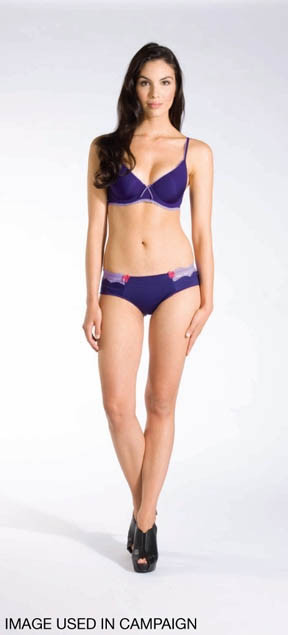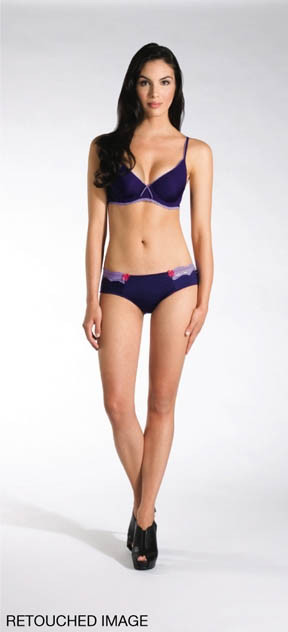Can’t (re)touch This
Quebec Retailer First to Fight Excessive Airbrushing
The oversaturated image of leggy, lean ladies that are the faces of the fashion industry may have met their match.
Cropped, chopped, touched and tweaked before being presented as reality, models in media and advertising beckon on a daily basis to buy, to try, to “be like” or “look like” and to romanticize some standard, some beauty myth, despite being a totally unrealistic, and often unhealthy, ideal for women and girls.
But one Canadian company says they have had enough.
On Sept. 1, JACOB, a Quebec-based women’s retailer, announced the launch of a “no retouching policy” for photos of its models—the first to publicly commit to not digitally alter the body shape of the women they hire to market their clothing and lingerie lines.
A part of me—the part that genuinely loves the look and squeeze of real lady flesh, and believes that being sexy or beautiful shouldn’t shame women out of shakin’ what their mommas gave them—wants to believe that this is a part of a marketing movement towards honest advertising, candid beauty and solid respect for the body issues women deal with on a regular basis.
While another part—the cynical, hardened, too-good-to-be-true journalist—wonders if this is just another bottom line, nickel-and-dime scheme to brand a company as “ethical” in terms of cultural consumption.
Is JACOB the champion of women’s bodies? I want to buy into this. But what is it? Is it really innovative? Or a successful branding scheme and savvy marketing?
I had to know, so I contacted JACOB for the real deal.
Cristelle Basmaji, a Concordia grad and current communications director of JACOB, told The Link that JACOB decided to implement the new policy this fall because the company “felt that the trend in digital photo manipulation had become excessive in recent months, and it was time for someone to take a stand and lead the debate on photo retouching.”
“Following positive feedback from customers over the past year about our restraints in the area of photo manipulation, we decided to push our commitment a step further by signing the Quebec Charter for a Healthy and Diverse Body Image and adopting an official policy,” she said via e-mail.
The Charter, which was developed in 2009, promotes more realistic body types in media, advertising and fashion.
Similar policies are part of a growing trend both in North America and overseas to curb excessively thin ideals for women and girls. But, as one marketing and advertising expert explained, it isn’t really a new idea.
“This is part of a larger social movement,” said Dr. Lea Prevel Katsanis, chair and associate professor in the department of marketing with the John Molson School of Business. “Retouching has been a controversy for the last two years or so.”
Initiated by Unilever—the brand behind Dove’s “Real Beauty” campaign—Katsanis believes that the presentation of non-Photoshopped women “really struck a cord with a large portion of the North American population,” and marketers clued into it en masse.
“It’s almost like the concept of sustainability,” she said. “Companies now have to find ways to be sustainable, because consumers want companies to be sustainable. In some ways, people want fashion to change and to evolve in a different way.”
Suspecting this will become an irreversible trend in advertising, as the North American population continues to become physically larger, Katsanis believes that JACOB’s clientele—“a middle-market” company catering to the 18-45 year-old demographic—is going to be more sensitive to issues of photo retouching than, say, high-end fashion lines.
But, she said, “the whole bottom line is that it’s been sparked by what is happening to young people, who really do take these images and see them as beyond aspirational […] and advertising is always, at some level, aspirational. You want something, whether it’s a sense of fun, a sense of belonging, prestige, beauty, whatever. Whatever the higher level motive is, that’s what advertising shoots for.”
She may have a point. But what are the advertisers who choose to Photoshop size-zero models even further shooting for, really?
In Quebec, many statistics suggest that the images of hyper-thin models have a dangerous effect on self-esteem and mental health of women and girls.
According to statistics from the Quebec Association for Assistance to People Suffering from Anorexia and Bulimia, between 40,000 and 65,000 women in Quebec suffer from some form of an eating disorder. According to the Douglas Hospital eating-disorder unit, 30,000 young Quebec women struggle with anorexia.
In the face of these numbers, JACOB’s decision to nix the Photoshop is another reason Katsanis believes them to be a “good corporate citizen.”
“This goes far beyond a marketing ploy,” she said. “If you can meet social trends and maintain a business profit, there’s all kinds of good things that can happen.”
So, whether or not JACOB wins their way into our wallets with this campaign, they are being transparent about the extremes of the industry and, in some way, giving women the advertising they’d like to see. And—in Quebec at least—a precedent has been set for other retailers to make untouched bodies and
healthy-looking ladies in vogue.
This article originally appeared in Volume 31, Issue 05, published September 14, 2010.



_600_832_s.png)
